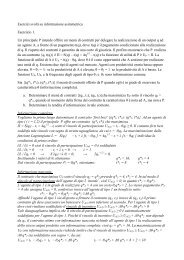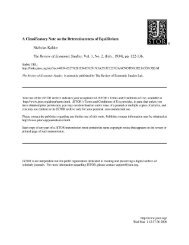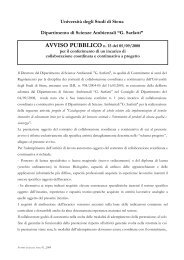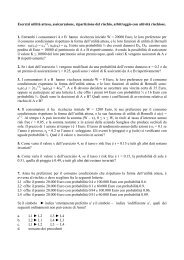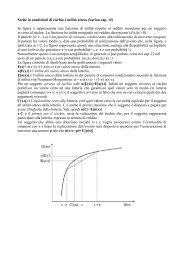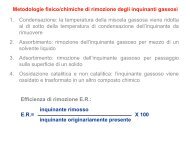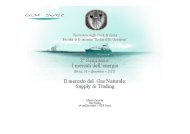86 THE ECONOMIC JOURNAL [MARCH<strong>of</strong> unstable; equilibrium would tend to get established <strong>the</strong>re, and,once established, <strong>the</strong> shifts in <strong>the</strong> I and S curves, due to capitaIaccumulation or decumulation, would merely lead to graduaIchanges in <strong>the</strong> level <strong>of</strong> activity unti! a position <strong>of</strong> stationarinessis reached; <strong>the</strong>y would not generate cyclical movements. Ifcondition (2) was not satisfied (at any rate as regards low levels <strong>of</strong>activity) 1 <strong>the</strong> system, as we have seen, would be so unstable thatcapitalism could not function at alI. Finally, if condition (3) didnot obtain, <strong>the</strong> cyclical movements would come to a halt at somestage, owing to a cessation <strong>of</strong> <strong>the</strong> movements <strong>of</strong> <strong>the</strong> S(x) andI(x) functions.This is not to suggest that in <strong>the</strong> absence <strong>of</strong> <strong>the</strong>se three conditionscyclical phenomena would be aItoge<strong>the</strong>r impossibIe.Only <strong>the</strong>y would have to be explained with <strong>the</strong> aid <strong>of</strong> differentprinciples; <strong>the</strong>y could not be accounted for by <strong>the</strong> savings andinvestment functions alone.8. In fact, conditions (1) and (2) are almost certain to besatisfied in <strong>the</strong> real world; doubt could only arise in connectionwith condition (3). It can be taken for granted, <strong>of</strong> course, thatnet investment will be positive while equilibrium is at position B;but it is by no means so certain that net investment will benegative while equilibr:ium is at position A.2 It is quite possible,for example, that savings should fall rapidly at a relatively earlystage <strong>of</strong> <strong>the</strong> downward movement, so that position A is reachedwhile net investment is stilI positive. In that case <strong>the</strong> Sand Icurves will stilI move in <strong>the</strong> same direction as at B, with <strong>the</strong> resultthat <strong>the</strong> position A is gradually shifted to <strong>the</strong> left, until netinvestment becomes zero. At that point <strong>the</strong> moven'lents <strong>of</strong> <strong>the</strong>I and S curves will cease; <strong>the</strong> forces making for expansion orcontractiQn come to a standstill. Alternatively, we might assumethat net investment at A is initially negative, but in <strong>the</strong> course <strong>of</strong><strong>the</strong> graduaI improvement, <strong>the</strong> position <strong>of</strong> zero net investment isreached before <strong>the</strong> forces <strong>of</strong> cumulative expansion couId come intooperation-i.e., somewhere during Stages IV and V, and before<strong>the</strong> cycle r:eaches Stage VI. In this case, too, <strong>the</strong> cyclical movementwill get into a deadlock.1 It is possible that <strong>the</strong> point B should be situated beyond <strong>the</strong> position <strong>of</strong> fullemployment-i.e., that in <strong>the</strong> course <strong>of</strong> <strong>the</strong> upward movement <strong>the</strong> state <strong>of</strong> fullemployment should be reached befolfe ex-ante Savings and Investment reachequality. In that case <strong>the</strong> upward movement would end in a state <strong>of</strong> cumulativeinflation, which in turn would, sooner or later, be brought to a halt by a rise ininterest rates sufficient to push <strong>the</strong> point B inside <strong>the</strong> full-employment barrier.From <strong>the</strong>n onwards <strong>the</strong> cyclical movement would proceed in exactly <strong>the</strong> samemanner as described.2 <strong>The</strong> term " net investment " here is used in <strong>the</strong> sense defined in § 6 (ii).
1940] A MODEL OF THE TRADE CYCLE 87Hence <strong>the</strong> forces making for expansion when we start from astate <strong>of</strong> depression are not so certam in <strong>the</strong>ir operation as <strong>the</strong>forces making for a down-turn when we start from prosperity;<strong>the</strong> danger <strong>of</strong> chronic stagnation is greater than <strong>the</strong> danger <strong>of</strong> achronic boom. A boom, if left to itself, is certain to come to anend; but <strong>the</strong> depression might get into a position <strong>of</strong> stationariness,and remain <strong>the</strong>re until external changes (<strong>the</strong> discovery <strong>of</strong> newinventions or <strong>the</strong> opening up <strong>of</strong> new markets) come to <strong>the</strong> rescue.9. <strong>The</strong> preceding analysis <strong>of</strong>fers also certain indicationsregarding <strong>the</strong> determination <strong>of</strong> t~e period and <strong>the</strong> amplitude <strong>of</strong><strong>the</strong> <strong>Cycle</strong>. <strong>The</strong> period <strong>of</strong> <strong>the</strong> Oycle seems to depend on two timelags,or ra<strong>the</strong>r time-rates <strong>of</strong> movement: (i) on <strong>the</strong> rate at which<strong>the</strong> Sand Icurves shift at any particular level <strong>of</strong> investment(this, <strong>of</strong> course, will vary with <strong>the</strong> level <strong>of</strong> investment, and willbe faster when investment is high or low, than in <strong>the</strong> middle);(ii) on <strong>the</strong> time taken to complete a ,t' cumulative movement "i.e., <strong>the</strong> time required for <strong>the</strong> system to travel from B + O to Aor from A + O to B (Stages III and VI).<strong>The</strong> second <strong>of</strong> <strong>the</strong>se factors obviously depends on <strong>the</strong> velocitywith which entrepreneurs and consumers adjust <strong>the</strong>ir expectationsand thus <strong>the</strong>ir buying-plans to unexpected changes in <strong>the</strong> situation.<strong>The</strong> first factor, on <strong>the</strong> o<strong>the</strong>r hand, seems to depend on technicaldata, on <strong>the</strong> construction period and durability <strong>of</strong> capitaI goods.<strong>The</strong> shorter <strong>the</strong> construction period, <strong>the</strong> greater will be <strong>the</strong> output<strong>of</strong> capitaI goods, per unit' period, at a given rat~ <strong>of</strong> investment;<strong>the</strong> shorter <strong>the</strong> life-tjme <strong>of</strong> capitaI goods, <strong>the</strong> larger willbe <strong>the</strong> percentage addition to total equipment represented by agiven output <strong>of</strong> capitaI goods. Hence <strong>the</strong> shorter <strong>the</strong> construction-period,and <strong>the</strong> lower <strong>the</strong> durability, <strong>the</strong> faster will be <strong>the</strong>rate <strong>of</strong> Sllift <strong>of</strong> <strong>the</strong> Sand I curves at any given rate <strong>of</strong> investment;<strong>the</strong> shorter <strong>the</strong> length <strong>of</strong> <strong>the</strong> <strong>Trade</strong> <strong>Cycle</strong>. 1As regards <strong>the</strong> amplitude, this depends on <strong>the</strong> shapes <strong>of</strong> <strong>the</strong>I and S curves, which determine <strong>the</strong> distance between A and B,at <strong>the</strong>ir "normal" position (i.e., at Stages I and IV). <strong>The</strong>amplitude will be alI <strong>the</strong> smaller <strong>the</strong> shorter <strong>the</strong> range <strong>of</strong> activityover which <strong>the</strong> "normal values" <strong>of</strong> ~~ and ~~ are operative.1 If <strong>the</strong> " capitaI intensity " <strong>of</strong> investments varies in <strong>the</strong> different phases <strong>of</strong><strong>the</strong> CycIe in an inverse relation to <strong>the</strong> rate <strong>of</strong> investment (i.e., is less in boomperiods than in depression periods), this will tend to reduce <strong>the</strong> period <strong>of</strong> <strong>the</strong>CycIe, as compared with a situation where <strong>the</strong> capitaI intensity is constant, sinceit will increase <strong>the</strong> rate <strong>of</strong> shift <strong>of</strong> <strong>the</strong> Sand I curves. ConverseIy, if capitaIintensity varied in direct relation with <strong>the</strong> rate <strong>of</strong> investment, this wouId Ieng<strong>the</strong>n<strong>the</strong> periodo Finally, if capitaI intensity showed a steady increase throughout <strong>the</strong>CycIe, this wouId Ieng<strong>the</strong>n <strong>the</strong> boom periods and shorten <strong>the</strong> depression periods.



